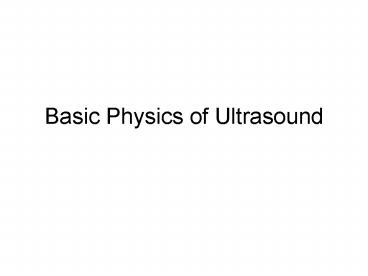Basic Physics of Ultrasound - PowerPoint PPT Presentation
1 / 17
Title:
Basic Physics of Ultrasound
Description:
... echolocation used by bats, whales and dolphins, as well ... The image is a 2D map of reflections displayed as a grey scale. B mode = brightness modulation ' ... – PowerPoint PPT presentation
Number of Views:4267
Avg rating:5.0/5.0
Title: Basic Physics of Ultrasound
1
Basic Physics of Ultrasound
2
WHAT IS ULTRASOUND?
- Ultrasound or ultrasonography is a medical
imaging technique that uses high frequency sound
waves and their echoes. - Known as a pulse echo technique
- The technique is similar to the echolocation used
by bats, whales and dolphins, as well as SONAR
used by submarines etc.
3
In ultrasound, the following events happen
- The ultrasound machine transmits high-frequency
(1 to 12 megahertz) sound pulses into the body
using a probe. - The sound waves travel into the body and hit a
boundary between tissues (e.g. between fluid and
soft tissue, soft tissue and bone). - 3. Some of the sound waves reflect back to the
probe, while some travel on further until they
reach another boundary and then reflect back to
the probe . - 4. The reflected waves are detected by the probe
and relayed to the machine.
4
- The machine calculates the distance from the
probe to the tissue or organ (boundaries) using
the speed of sound in tissue (1540 m/s) and the
time of the each echo's return (usually on the
order of millionths of a second). - 6. The machine displays the distances and
intensities of the echoes on the screen, forming
a two dimensional image.
5
So.
- All the energy comes from the transducer
- All we see are reflections and scatter.
6
SOUND
- Sound waves consist of mechanical vibrations
containing condensations (compressions)
rarefactions (decompressions)that are transmitted
through a medium. - Sound is mechanical.
- Sound is not electromagnetic.
- Matter must be present for sound to travel
7
Compression wave
8
CATEGORIES OF SOUND
- Infrasound (subsonic) below 20Hz
- Audible sound 20-20,000Hz
- Ultrasound above 20,000Hz
- Nondiagnostic medical applications lt1MHz
- Medical diagnostic ultrasound gt1MHz
9
THE TRANSDUCER
- Piezo-electric crystal
- Converts electric signals to mechanical vice
versa - Transmits pulses of sound into tissue and listens
for echos - Most of the time is spent listening for echoes
10
Power off Transducer receiving echoes
Transducer Power on
10-6sec
10-3sec
11
(No Transcript)
12
ULTRASOUND PULSESMAKING THE IMAGE
- Echoes occur when pulses of U/S hit reflectors
- A stream of echoes from each pulse return to
transducer - Deeper echoes from deeper tissues arrive later
- Stronger echoes arrive from stronger reflectors
- Each transducer has many elements each making
pulses (150-200)
13
Perfect Reflection
Transducer
Object
Distance (d) is proportional to time (t)
If you know the velocity (c) then the distance
is d1/2 (cxt)
Cfxl, so we can work out frequency and
wavelength too
14
ULTRASOUND PULSESMAKING THE IMAGE
- The image is a 2D map of reflections displayed as
a grey scale - B mode brightness modulation
- Real time is lots of B mode images run together
15
SOUND WAVES
- WAVELENGTH IS VERY SMALL
- OBEY THE LAWS OF OPTICS
16
SOUND WAVES
- Gathered into a narrow beam
- Reflected
- Refracted
- Scattered
- Absorbed
- Undergo interference
17
Components Of B mode Real time machine
TIME IS OF THE ESSENCE































